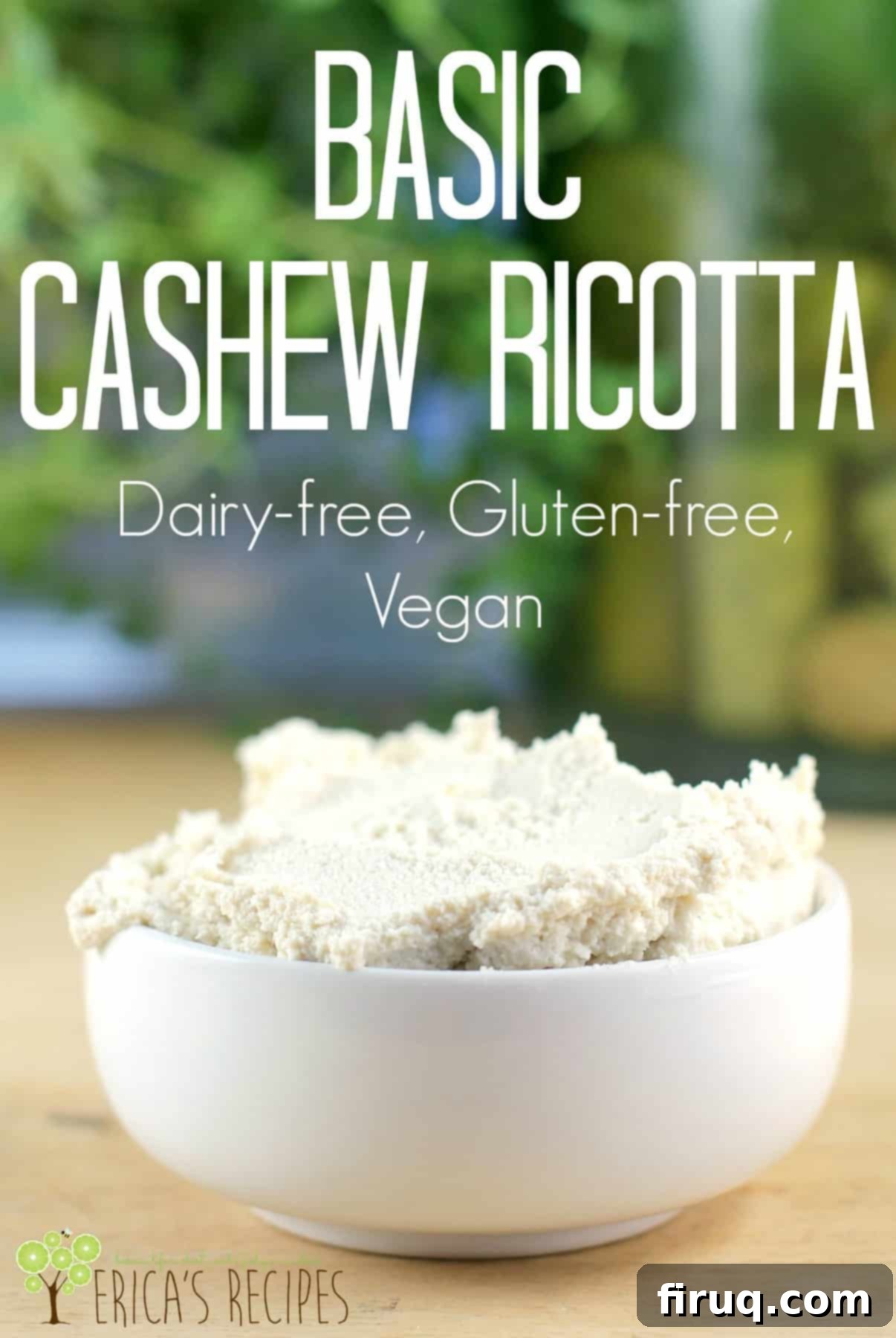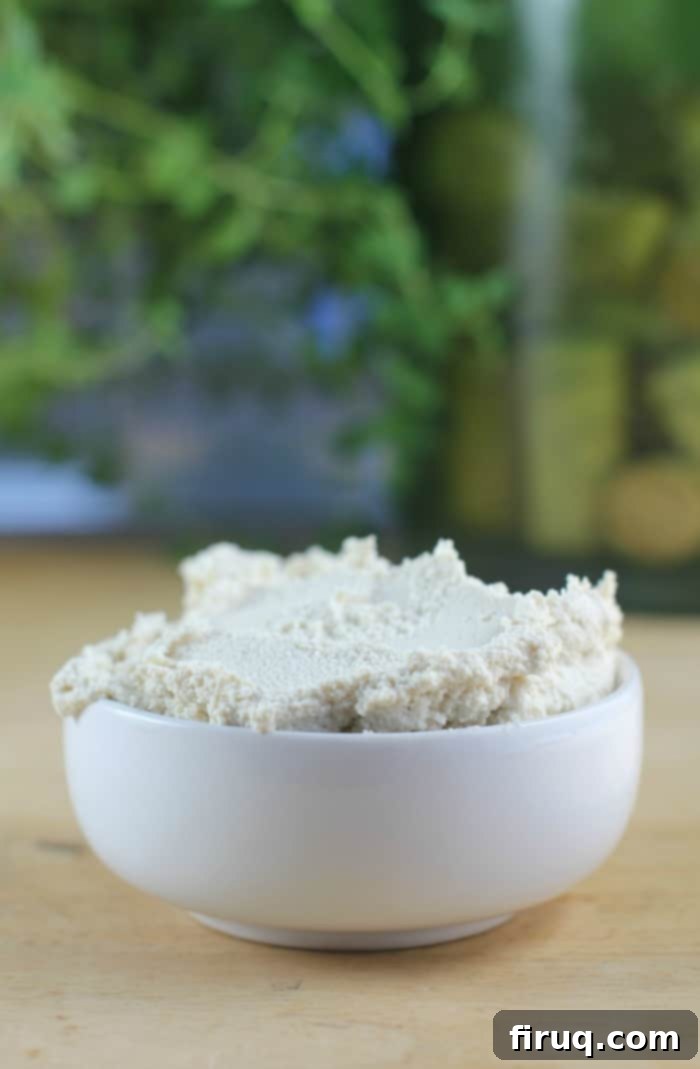Creamy Vegan Cashew Ricotta: Your 3-Ingredient Dairy-Free Dream Cheese
Welcome to the wonderful world of Basic Cashew Ricotta – your ultimate plant-based alternative to traditional ricotta cheese. Crafted with just three core ingredients, this recipe harnesses the incredible transformative power of raw cashews. When properly soaked and blended, these humble nuts magically transform into a rich, creamy, and remarkably dairy-like spread, without a single drop of actual dairy. Prepare to be amazed by its texture, versatility, and undeniable deliciousness!
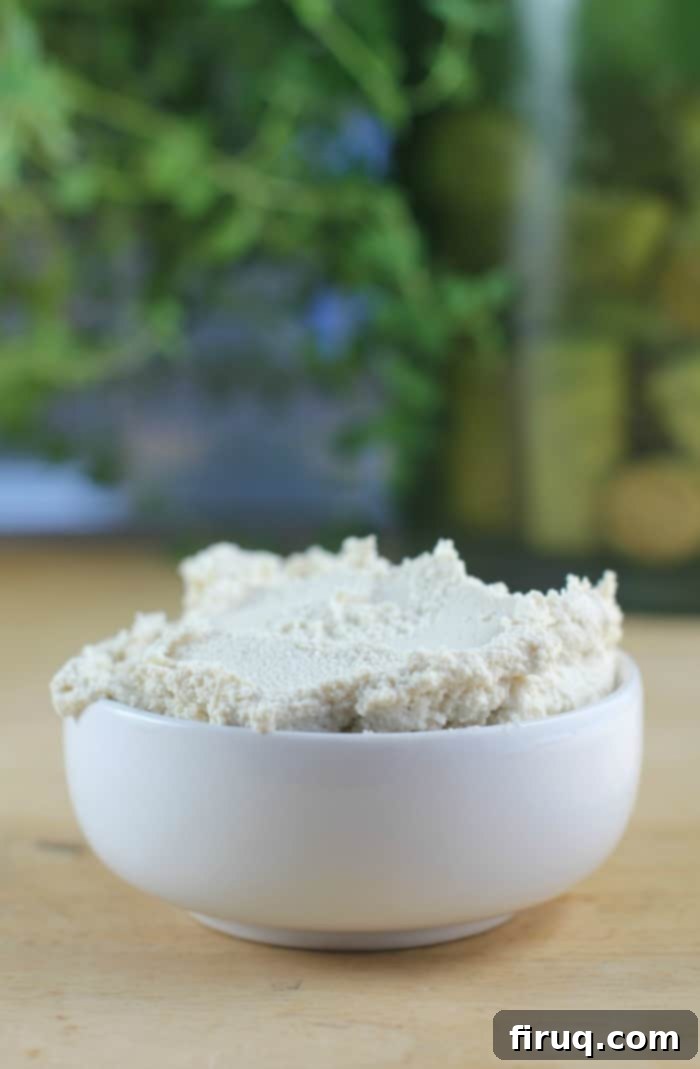
Why Cashews Are the Secret to the Best Vegan Ricotta
The magic behind this incredibly smooth and luscious vegan ricotta lies squarely with raw cashews. Unlike many other nuts, cashews boast a naturally creamy texture and a mild flavor profile that makes them ideal for mimicking dairy products. When soaked in water, cashews soften significantly, allowing them to break down completely in a food processor or high-speed blender. This process creates an emulsified, rich paste that perfectly replicates the consistency and mouthfeel of traditional ricotta cheese.
Beyond their texture, cashews offer a wealth of nutritional benefits. They are packed with healthy monounsaturated fats, essential minerals like magnesium, zinc, and copper, and a good amount of plant-based protein. Choosing cashew ricotta is not just a delicious culinary decision; it’s also a choice for a healthier, more sustainable diet. This simple recipe proves that eating dairy-free doesn’t mean compromising on taste or texture, especially when it comes to beloved creamy elements like ricotta.
Endless Culinary Possibilities with Your Homemade Cashew Ricotta
This basic cashew ricotta recipe isn’t just a substitute; it’s a versatile culinary staple that will quickly become a favorite in your kitchen. Its applications are truly limitless, making it an indispensable component for both savory and sweet dishes. Here are just a few ideas to get you started, demonstrating how this simple creation can revolutionize your plant-based cooking:
- Direct Ricotta or Cream Cheese Substitute: Use it straight from the fridge as a direct 1:1 replacement in any recipe calling for dairy ricotta. Think classic lasagna, hearty stuffed shells, savory tarts, or even dolloped generously onto pizzas and baked pasta dishes for that unmistakable creamy touch. Its delightful tang and firm yet spreadable texture also make it an excellent stand-in for cream cheese on bagels, toast, or as a sophisticated base for various dips and spreads. It holds its shape beautifully when baked, making it perfect for filling pastries or cannelloni.
- Light & Creamy Sauces: For a lighter, pourable cream or an elegant sauce, simply thin out your cashew ricotta with a splash of unsweetened almond milk, oat milk, or even water. Blend until you reach your desired consistency. This creates a fantastic foundation for creamy pasta sauces (like an alfredo alternative), rich soups, vibrant salad dressings, or as a decadent, velvety topping for roasted vegetables. Remember to adjust seasonings to match your dish – a little garlic powder and nutritional yeast can elevate a savory cream, while a touch of maple syrup and vanilla transforms it into a delightful sweet drizzle for desserts.
- Gluten-Free Thickener: The natural richness and emulsifying properties of cashews make this ricotta an excellent gluten-free thickener for various recipes. Stir a spoonful or two into stews, curries, gravies, or casseroles towards the end of cooking to add body and a velvety texture without relying on flour, cornstarch, or other gluten-containing agents. It provides a luxurious creaminess that enhances the overall richness and mouthfeel of your dishes, making them feel more substantial and satisfying.
- Spread for Sandwiches & Wraps: Elevate your everyday lunches by spreading a generous layer of cashew ricotta onto sandwiches, wraps, or even warm flatbreads. It provides a burst of flavor and a creamy, satisfying element. Pair it with fresh crisp vegetables, sun-dried tomatoes, grilled plant-based proteins, or a sprinkle of fresh herbs for a gourmet touch.
- Dessert Base: With a few simple additions like a dash of vanilla extract, a natural sweetener (such as maple syrup, agave, or a few softened dates), and perhaps a pinch of cinnamon or cardamom, this basic ricotta can be transformed into a delightful dessert component. Use it as a creamy layer in parfaits with fruit and granola, as a filling for fruit tarts, or even as a surprisingly healthy and light frosting for cakes and cupcakes.
Prepare a batch and keep it readily available in your refrigerator for up to a week. Its convenience and adaptability mean you’ll find yourself reaching for it constantly, discovering new ways to incorporate its delightful creaminess into your everyday meals. The possibilities are truly endless, limited only by your imagination and culinary curiosity!
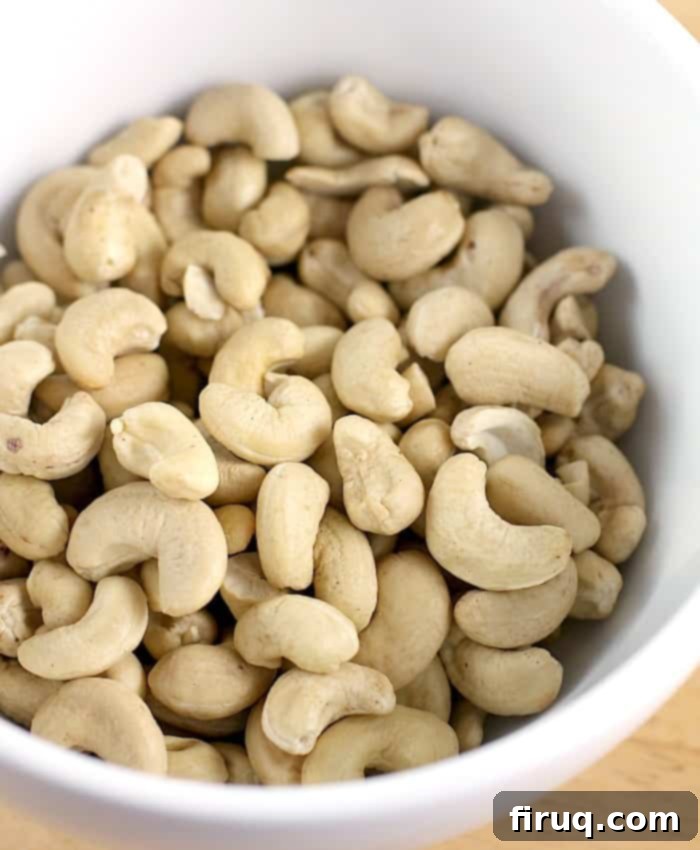
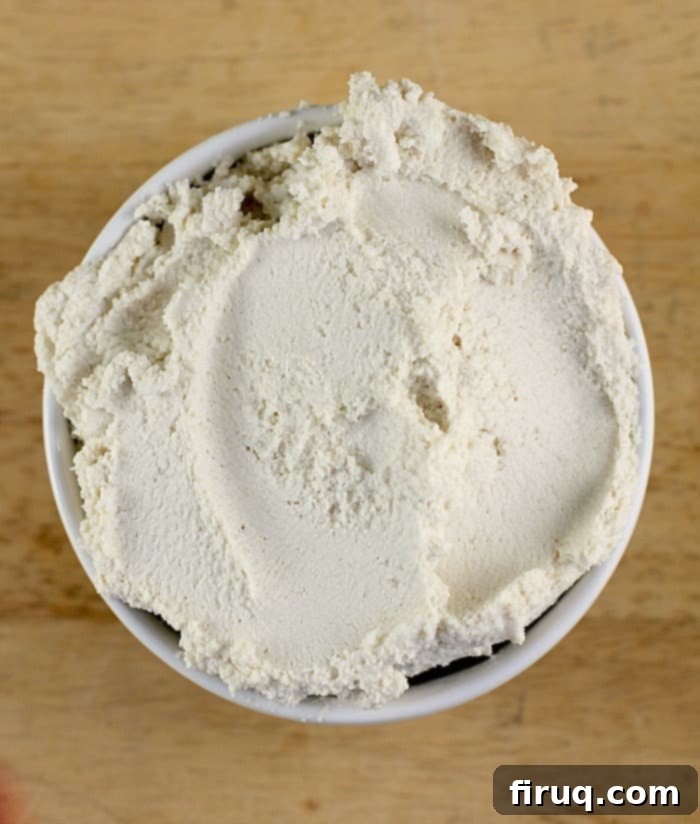
Mastering the 3 Key Ingredients for Perfect Cashew Ricotta
This recipe prides itself on its simplicity, relying on the quality and interplay of just three essential ingredients to create a truly remarkable dairy-free ricotta. Understanding the role of each component will help you achieve consistent, delicious results every time you make this plant-based wonder.
1. Raw Cashews: The Creamy Foundation
As mentioned, raw cashews are the absolute star of this show. It’s crucial to use *raw*, unsalted cashews, not roasted or salted ones, as roasting alters their flavor profile and can make them less suitable for a neutral, creamy base. Soaking them is also non-negotiable for optimal creaminess and digestibility. Overnight soaking is ideal (8-12 hours in cool water), but if you’re short on time, a quick soak in boiling water for 30-60 minutes can work in a pinch, though the texture might be slightly less smooth. Soaking softens the nuts, making them easier to blend into a perfectly silky consistency.
2. Fresh Lemon Juice: The Zesty Brightener
Freshly squeezed lemon juice plays a crucial dual role in this recipe. Firstly, it provides the necessary acidic component that helps cut through the inherent richness of the cashews, mimicking the subtle tang and freshness found in traditional dairy ricotta. This acidity balances the flavors beautifully. Secondly, lemon juice acts as a natural preservative, helping to extend the shelf life of your homemade ricotta, keeping it fresh and vibrant for longer. Always opt for fresh lemon juice over bottled for the best flavor and brightest zest.
3. Dijon Mustard: The Umami Enhancer
While it might seem like an unconventional addition, Dijon mustard is the secret ingredient that truly elevates this cashew ricotta from merely good to absolutely extraordinary. Its subtle pungency and savory depth add a complex umami note that rounds out the flavor profile, making it more sophisticated and satisfyingly “cheesy.” Don’t worry, your ricotta won’t taste overtly like mustard – it simply enhances the overall savory qualities, creating a more robust and truly irresistible dairy-free experience.
*(Optional, but highly recommended: A pinch of salt. While not one of the “core three,” salt is vital for seasoning and can be adjusted to taste at the end, bringing all the flavors together.)*
Step-by-Step Guide to Making Your Own Cashew Ricotta
Making this vegan ricotta is surprisingly straightforward and requires minimal effort, especially if you plan ahead for soaking. Follow these detailed steps to ensure a perfectly smooth, thick, and flavorful batch every time.
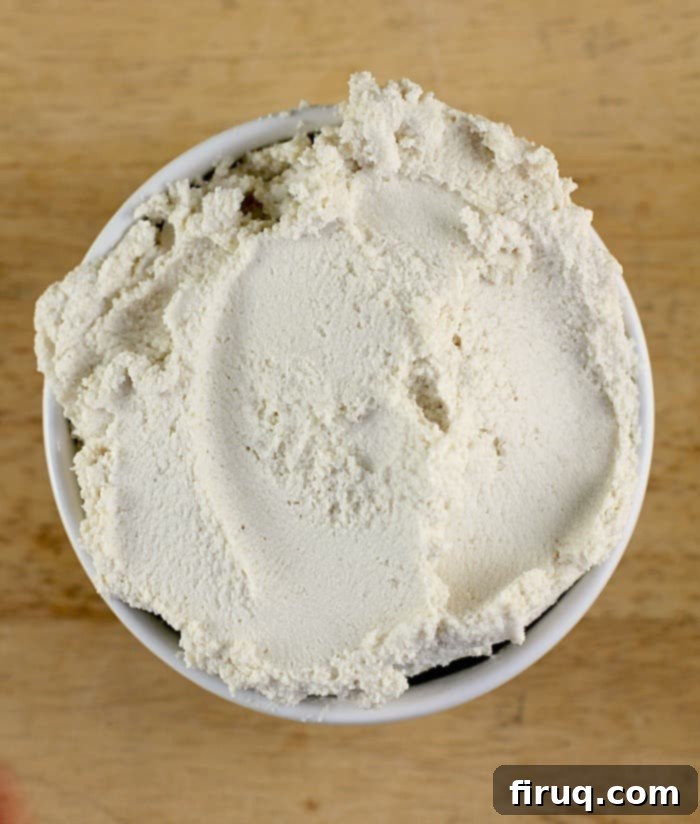
Basic Cashew Ricotta (Vegan & Dairy-Free)
Print
Pin
Rate
Ingredients
- 8 oz raw cashews, soaked overnight or quick-soaked (see notes for details)
- 1 tsp Dijon mustard
- juice of 1 small fresh lemon (about 2 tablespoons)
- ¼ – ½ tsp salt (to taste, optional but highly recommended)
Instructions
-
Soak the Cashews: Place the raw cashews in a medium-sized bowl and cover them completely with fresh, cool water. Let them soak overnight at room temperature for a minimum of 8 hours, or up to 12 hours. This long soak is key for the creamiest texture. If you’re in a hurry, you can opt for a quick soak by covering the cashews with boiling water and letting them sit for at least 30 minutes, or up to an hour. The longer they soak, the smoother and more dairy-like your ricotta will be. Soaking can be done a couple of days in advance; just ensure the cashews are stored in the fridge, covered in fresh water.
-
Prepare for Blending: Once the cashews are sufficiently soaked, thoroughly drain them using a fine-mesh sieve. Rinse them well under fresh running water to remove any lingering impurities from the soaking process. Transfer the rinsed cashews directly to the bowl of a powerful food processor.
-
Initial Blend: Begin by pulsing and processing the cashews to break them down into a fine, crumbly meal. This initial step ensures even blending. Stop and scrape down the sides of the bowl periodically with a spatula to push any unblended pieces back towards the blades. Continue this process until no large, whole cashew pieces remain and the mixture has a fine, granular texture.
-
Add Flavorings: With the cashews finely ground, add the Dijon mustard and the freshly squeezed lemon juice to the food processor. Now is also the perfect time to add your initial ¼ teaspoon of salt, if using. The acidity and savory notes will begin to transform the base flavor.
-
Achieve Creaminess: Continue to process the mixture continuously. You’ll notice it start to clump together and then gradually smooth out. Stop every minute or so to scrape down the sides of the bowl again. This is a crucial step to ensure a uniformly smooth texture. Keep blending until the cashew mixture becomes very smooth, thick, and creamy, closely resembling traditional ricotta cheese in both appearance and consistency. This can take several minutes, depending on the power of your food processor. Be patient; achieving the perfect consistency is key!
-
Taste and Adjust: Once you’ve achieved your desired smooth and creamy texture, taste the ricotta. This is where you can truly personalize it. If desired, add an additional pinch of salt to brighten the flavors, more lemon juice for extra tang, or a touch more Dijon for increased umami depth. Remember, this is a base recipe, and your personal preference for seasoning is important for the final dish you plan to use it in.
-
Store: Transfer the finished cashew ricotta to an airtight container. It’s ready to use immediately or can be stored in the refrigerator for up to 7 days. This recipe yields approximately 1.5 cups of delicious, versatile vegan ricotta, perfect for a week’s worth of plant-based creations.
Notes for Success & Customization
For Creamier or Thinner Consistencies: If you’re looking to create a pourable cream, a smoother sauce, or a spread with a lighter texture, incrementally add a tablespoon of unsweetened almond milk (or your preferred plant-based milk) during the final blending stage. Blend thoroughly after each addition until your desired consistency is reached. Start with small amounts to avoid making it too thin too quickly.
Seasoning is Key: While the base recipe is excellent, if you’re using this cashew ricotta as the primary ingredient in a dish (like a standalone spread, dip, or as a layer in lasagna), you will absolutely need to adjust the seasoning to taste. Don’t be shy with adding more salt and lemon juice – they are crucial for cutting through the rich fat content of the cashews and bringing out vibrant flavors. The Dijon mustard provides that essential umami depth, making it truly satisfying. For an even cheesier or more savory profile, feel free to blend in a pinch of garlic powder, onion powder, or 1-2 tablespoons of nutritional yeast.
Quick Soaking Method for When You’re in a Hurry: If you forgot to soak your cashews overnight, don’t fret! Place them in a bowl, cover with boiling water, and let them sit for 30-60 minutes. Drain and rinse thoroughly before proceeding with the recipe. While overnight soaking yields the absolute creamiest and smoothest result, the quick soak method is a perfectly acceptable alternative for when you’re short on time.
Nutrition Information (Per Serving)
Tips for Optimal Creaminess and Flavor
Achieving the perfect texture and flavor for your homemade cashew ricotta is simple when you keep these key tips in mind:
- Soaking Time is Crucial: For the silkiest, smoothest ricotta, don’t skimp on the soaking time. Overnight (8-12 hours) in cool water is ideal. This fully hydrates the cashews, allowing them to break down completely and blend into an incredibly fine, velvety texture with no grittiness. While a quick soak in boiling water works, the texture might be slightly less refined.
- High-Powered Blender vs. Food Processor: A food processor is excellent for achieving a thick, slightly textured, ricotta-like consistency. If you desire an even smoother, almost cream-cheese-like consistency, or are making a thinner sauce, a high-speed blender can achieve this with minimal effort and potentially less scraping. Just be sure to add a tiny bit of water or plant milk if using a blender to help it process and keep the blades moving.
- Adjust Seasoning to Taste: This is a base recipe designed for maximum versatility. Always taste your ricotta after blending and before incorporating it into a final dish. You might want to add more salt to truly bring out the flavors, a squeeze of additional lemon juice for extra brightness and tang, or even a tiny bit of garlic powder or nutritional yeast, especially if you plan to use it as a standalone spread or dip. The salt and lemon are essential for brightening the flavor profile and cutting through the natural richness of the cashews.
- Scrape Down the Bowl: During blending, especially in a food processor, cashews tend to stick to the sides of the bowl. Stop frequently and scrape down the sides with a spatula to ensure all pieces are incorporated and blend evenly. This prevents chunky bits and ensures uniform creaminess.
- Storage: Store your homemade cashew ricotta in an airtight container in the refrigerator. It will stay fresh and delicious for up to 7 days. It might firm up slightly in the fridge; if needed, let it sit at room temperature for 10-15 minutes or stir in a tiny bit of plant milk to soften before use. Slight separation might occur over time, but a quick stir will bring it back together perfectly.
Creative Flavor Variations for Your Cashew Ricotta
While this basic recipe is fantastic as is, it also serves as an excellent canvas for culinary creativity and customization. Don’t be afraid to experiment and infuse your cashew ricotta with different flavors to suit your palate and the dish you’re preparing. Here are some inspiring ideas:
- Classic Herbed Ricotta: For a fresh and aromatic spread, stir in finely chopped fresh herbs like basil, chives, parsley, oregano, or dill after the main blending process. This variation is perfect for savory dishes, elegant crostini, or as a vibrant topping for bruschetta and avocado toast.
- Garlic & Herb Ricotta: Take the herbed version a step further by adding one or two cloves of raw garlic directly to the food processor along with the soaked cashews, lemon juice, and Dijon. You can also include dried herbs like a mix of Italian seasoning or Herbes de Provence for a deeper, more robust flavor.
- Spicy Ricotta: If you enjoy a bit of heat, blend in a pinch of red pepper flakes, a dash of your favorite hot sauce, or a small amount of finely minced fresh chili pepper. This spicy kick is ideal for tacos, wraps, chili, or incorporating into spicy pasta dishes.
- Cheesy Ricotta (Nutritional Yeast): For an extra “cheesy” and umami-rich flavor profile, add 1-2 tablespoons of nutritional yeast to the food processor when you add the lemon juice and Dijon. This is especially good for recipes where you want a more pronounced, savory cheese-like taste, such as a hearty vegan lasagna, cheesy dips, or mac and cheese sauces.
- Sweet Ricotta for Desserts: For delightful dessert applications, omit the Dijon mustard (or significantly reduce it to just a tiny dash for complexity). Instead, add a tablespoon or two of maple syrup, agave nectar, or a few softened pitted dates for natural sweetness. A pinch of cinnamon, a splash of vanilla extract, or even a bit of orange or lemon zest can further enhance these sweet versions. Use this for fruit parfaits, as a filling for fruit tarts, or as a healthier sweet spread.
- Smoked Ricotta: For a unique depth of flavor, add a tiny pinch of smoked paprika or a drop of liquid smoke (start with very little and add more to taste) to the blend. This creates a wonderfully complex ricotta perfect for BBQ sandwiches or dishes needing a smoky undertone.
Make This Dairy-Free Staple Your Own!
This Basic Cashew Ricotta truly is a game-changer for anyone looking for a delicious, easy, and incredibly versatile dairy-free alternative to traditional ricotta cheese. With minimal ingredients and straightforward steps, you can create a creamy, flavorful spread that will elevate countless dishes in your kitchen. Whether you’re navigating a vegan lifestyle, have dairy intolerances, or are simply exploring new and exciting plant-based options, this recipe proves that you absolutely don’t have to sacrifice flavor, texture, or culinary creativity.
We encourage you to experiment with the numerous variations suggested, adjust the seasonings to your personal liking, and fearlessly integrate this incredible homemade cashew ricotta into all your favorite meals. Once you experience its rich creaminess and adaptable nature, we are confident that you’ll agree the possibilities are truly endless. This recipe is destined to become a cherished and frequently used staple in your culinary repertoire. Enjoy the process, and most importantly, enjoy the delicious results!
~✿♥✿~
